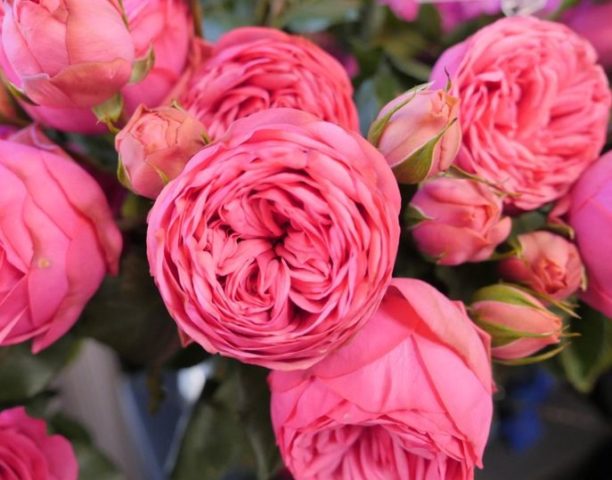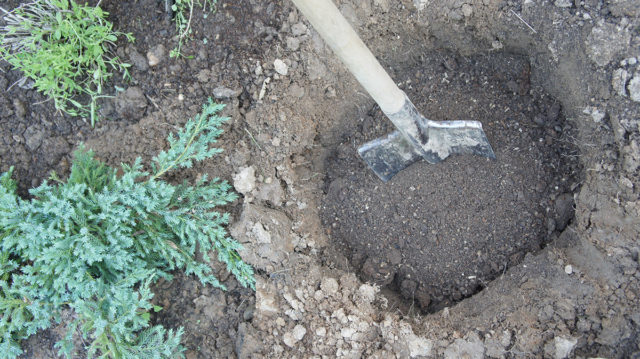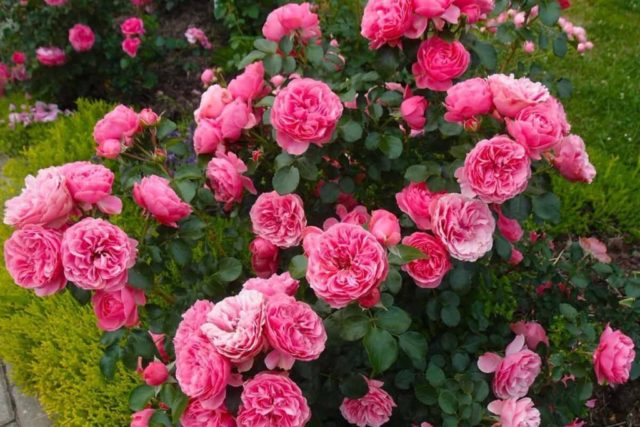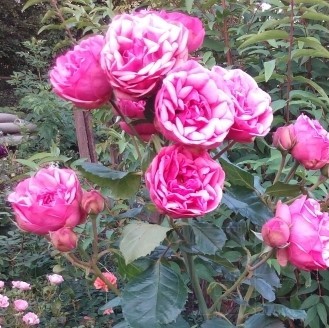Content
Rose Pink Piano is a bright beauty with carmine petals from the German Piano line, which is loved and respected by many gardeners around the world. The bush attracts attention with its bud shape. The flower seems to be a revived copy of a rose, transferred by a wave of the wizard's hand to the modern world from the canvases of old paintings by English artists.

Pink Piano rose flower has over a hundred petals
Breeding history
The Piano Pink rose variety is classified as hybrid tea. It was introduced by breeders from Germany at the beginning of the 21st century. Rose Piano pink was presented to the public in 2007 by the Tantau nursery, located in the north of Germany and conducting research work for more than a hundred years.
Breeders used tea rose and hybrids with luxurious double buds to obtain the variety. As a result, the Pink Piano rose has the best properties of both parents. Duration of flowering of tea culture, large double bud from hybrids and their famous winter hardiness.
Nature itself made a significant contribution to the creation of this tea type of rose. The hybrid was formed in vivo on its own. It is one of the most demanded flowers for cutting material.
Pink Piano rose description and characteristics
The rose bush, compact in width, reaches a height of more than a meter. The stems are erect, resilient and powerful, reddish in color, the leaves are shiny, dark in color, dense to the touch, reminiscent of expensive leather.
The flower of the rose is peony, in the half-open state it has the shape of a ball, in the open state it is a bowl with a huge number of gracefully curved petals of the classical form. The aroma is long-lasting, with a raspberry hue, delicate and elegant.
With good nutrition and proper care of the Pink Piano rose bush, the size of a blossoming bud can reach 12 centimeters in diameter. The color is pink, bright and saturated, over time, under the influence of solar ultraviolet radiation, it becomes just a pale pink.

A bouquet of exquisite roses Piano Pink will decorate any celebration
The inflorescences of the bush are dense, contain from 3 to 7 buds. There may be single flowers, it all depends on climatic conditions and care.
Rosa Piano Pink belongs to the re-flowering varieties, pleases gardeners with secondary flowering, which comes closer to autumn, after a one and a half month break.
Advantages and disadvantages of the variety
Rose bush Pink Piano inherited from its ancestors all the positive qualities of natural hybrids:
- High resistance to infectious diseases such as black spot and powdery mildew.
- Resistant to wind gusts and vertical blows of rain, the bush and rose inflorescences do not lose their decorative effect even after severe weather.
- Resistance to heat and cold weather, easily tolerates return frosts in spring.
- Long re-flowering.
There are no clearly pronounced shortcomings in the Piano Pink variety, the only feature is the careful selection of the planting site for the bush.Direct sunlight from the sun at its zenith can cause burns on the petal plates of a rose, therefore, shading, natural or artificial, is required in hot daytime hours.
Reproduction methods
For propagation of varieties of roses obtained by crossing, only vegetative methods are used. Pink Piano is no exception. There are three methods for this look:
- Layering... At the very beginning of summer, they choose a mature last year's shoot and bend it to the ground. The place of contact with the ground half a meter from the mother bush is fixed with a wire hook, after which it is sprinkled with a layer of soil 5-8 cm thick. The rooting site is constantly moistened from a watering can; complete drying out of the soil is unacceptable. The next spring, a young rose plant is cut off from the main bush and transplanted to a prepared place.
- Graft... In early spring, a rose shoot is grafted onto a two-year-old rosehip seedling.
- Dividing the bush... It is performed in early spring, immediately after the snow cover has melted. A part of the bush is cut off with a sharp shovel and transplanted to a new place, slightly shortening the roots.

It is better to prepare the Pink Piano rose hole in the fall, the fertilizers applied during the winter period will saturate the soil with useful substances
Growing and care
The main point in the agrotechnical approach to growing a plant such as the Pink Piano hybrid tea rose is the correct selection of a permanent place:
- sun rays in the morning, with light partial shade at noon;
- lack of drafts and strong winds;
- moderate ventilation.
The soil, ideal for the Pink Piano rose bush, is black soil or loam, with an admixture of organic matter. In places with a high level of groundwater, drainage must be arranged in the root zone.
After planting, a young Pink Piano plant must be shaded during hot hours and watered regularly.
Roses are fed three times per season on wet soil:
- in the spring, nitrogen fertilizers are applied:
- in summer - phosphorus-calcium;
- in the fall - potassium.
Application rates must comply with the instructions for the use of a particular drug.
Watering the Pink Piano rose bush is carried out regularly, but in moderation, excessive waterlogging leads to the development of fungal root diseases. It is best to combine watering with regular loosening of the soil and mulching of the surface layer.
The frost resistance of the plant is commendable, but when grown in regions with long and harsh winters, the Pink Piano rose variety requires additional shelter. With the onset of stable frosts, the root system is insulated with organic residues, peat, sawdust, coniferous spruce branches and other materials at hand. Foam caps are good for insulation and pyramidal shape.
Pests and diseases
Rose Piano Pink is not susceptible to diseases with an infectious nature, such as black spot or powdery mildew, but, like all plants on Earth, it can be attacked by garden pests.
In this case, the florist should take urgent measures to protect the bush. If the leaf blades and inflorescences are covered with mechanical damage, it means that the roses have been attacked by caterpillars or slugs. With an aphid invasion, the leaves of the plant are covered with a sticky bloom, the spider mite leaves a white bloom on the leaf blades, similar to a small cobweb. Any pests can be easily destroyed by abundantly spraying the green mass of the bush with a systemic insecticide, which can be bought in shops for gardeners and gardeners.
If the damage on the rose is small, you can mechanically clean the bush and remove the leaves and inflorescences affected by pests.
Application in landscape design
Shrub rose Pink Piano carries the spirit of English aristocracy with a light patina of exquisite antiquity. Tall shoots and splendor of dense foliage, combined with refined luxurious buds, allow decorators and landscape designers to create magnificent compositions on its basis in gardens and parks.

Piano Pink rose bush - a wonderful decoration for a garden or park
The bush looks great both in single plantings and in a group, rose gardens or large flower beds. The external resemblance of rosebuds to peonies allows these plants to be used in group plantings, complementing and emphasizing the beauty of each other. The colors are selected in the same key, or, on the contrary, the contrast effect comes to the fore.
Conclusion
Rose Pink Piano is a frost-resistant plant that is not prone to infection with infectious diseases. The beauty of the inflorescences and the unusual shape of the bud, the bright carmine color of the petals, the powerful bush invariably attract the attention of connoisseurs, inspire lovers of landscape art to create new exquisite compositions.










